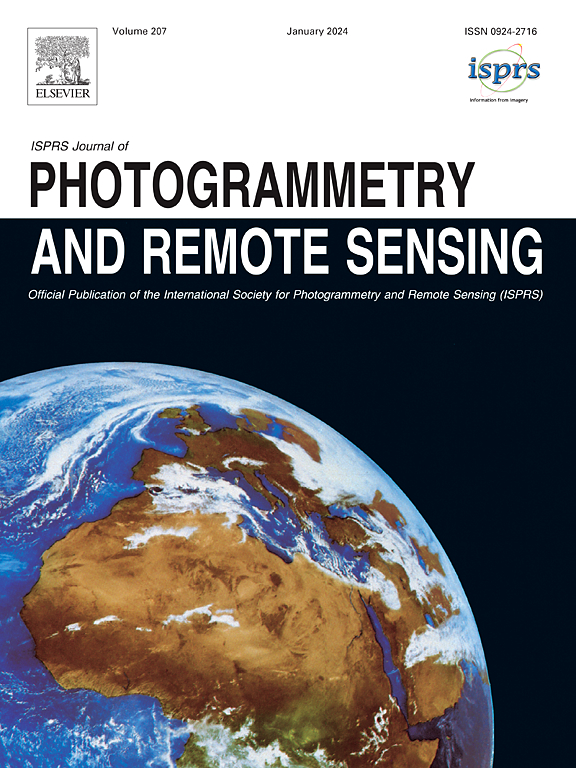Atmospheric correction of geostationary ocean color imager data over turbid coastal waters under high solar zenith angles
IF 10.6
1区 地球科学
Q1 GEOGRAPHY, PHYSICAL
ISPRS Journal of Photogrammetry and Remote Sensing
Pub Date : 2024-10-31
DOI:10.1016/j.isprsjprs.2024.10.018
引用次数: 0
Abstract
The traditional atmospheric correction models employed with the near-infrared iterative schemes inaccurately estimate aerosol radiance at high solar zenith angles (SZAs), leading to a substantial loss of valid products for dawn or dusk observations by the geostationary satellite ocean color sensor. To overcome this issue, we previously developed an atmospheric correction model suitable for open ocean waters observed by the first geostationary satellite ocean color imager (GOCI) under high SZAs. This model was constructed based on a dataset from stable open ocean waters, which makes it less suitable for coastal waters. In this study, we developed a specialized atmospheric correction model (GOCI-II-NN) capable of accurately retrieving the water-leaving radiance from GOCI-II observations in coastal oceans under high SZAs. We utilized multiple observations from GOCI-II throughout the day to develop the selection criteria for extracting the stable coastal water pixels and created a new training dataset for the proposed model. The performance of the GOCI-II-NN model was validated by in-situ data collected from coastal/shelf waters. The results showed an Average Percentage Difference (APD) of less than 23% across the entire visible spectrum. In terms of the valid data and retrieval accuracy, the GOCI-II-NN model was superior to the traditional near-infrared and ultraviolet atmospheric correction models in terms of accurately retrieving the ocean color products for various applications, such as tracking/monitoring of algal blooms, sediment dynamics, and water quality among other applications.
太阳高天顶角下浑浊沿岸水域地球静止海洋彩色成像仪数据的大气校正
传统的近红外迭代方案所采用的大气校正模型对高太阳天顶角(SZA)下气溶胶辐射率的估计不准确,导致地球静止卫星海洋色彩传感器在黎明或黄昏观测时有效产品的大量损失。为了解决这个问题,我们之前开发了一个大气校正模型,适用于第一颗地球静止卫星海洋彩色成像仪(GOCI)在高日照角下观测到的开阔海域。该模型是基于稳定的开阔海域数据集构建的,因此不太适合沿岸海域。在这项研究中,我们开发了一种专门的大气校正模式(GOCI-II-NN),能够在高 SZAs 条件下从 GOCI-II 观测数据中准确获取沿岸海域的离水辐射率。我们利用来自 GOCI-II 的全天多次观测数据,制定了提取稳定沿岸水域像素的选择标准,并为所提出的模式创建了一个新的训练数据集。从沿岸/大陆架水域收集的现场数据验证了 GOCI-II-NN 模式的性能。结果显示,在整个可见光谱范围内,平均百分比差异(APD)小于 23%。在有效数据和检索精度方面,GOCI-II-NN 模型优于传统的近红外和紫外大气校正模型,能准确检索出各种应用领域的海洋颜色产品,如跟踪/监测藻华、沉积物动力学和水质等。
本文章由计算机程序翻译,如有差异,请以英文原文为准。
求助全文
约1分钟内获得全文
求助全文
来源期刊

ISPRS Journal of Photogrammetry and Remote Sensing
工程技术-成像科学与照相技术
CiteScore
21.00
自引率
6.30%
发文量
273
审稿时长
40 days
期刊介绍:
The ISPRS Journal of Photogrammetry and Remote Sensing (P&RS) serves as the official journal of the International Society for Photogrammetry and Remote Sensing (ISPRS). It acts as a platform for scientists and professionals worldwide who are involved in various disciplines that utilize photogrammetry, remote sensing, spatial information systems, computer vision, and related fields. The journal aims to facilitate communication and dissemination of advancements in these disciplines, while also acting as a comprehensive source of reference and archive.
P&RS endeavors to publish high-quality, peer-reviewed research papers that are preferably original and have not been published before. These papers can cover scientific/research, technological development, or application/practical aspects. Additionally, the journal welcomes papers that are based on presentations from ISPRS meetings, as long as they are considered significant contributions to the aforementioned fields.
In particular, P&RS encourages the submission of papers that are of broad scientific interest, showcase innovative applications (especially in emerging fields), have an interdisciplinary focus, discuss topics that have received limited attention in P&RS or related journals, or explore new directions in scientific or professional realms. It is preferred that theoretical papers include practical applications, while papers focusing on systems and applications should include a theoretical background.
 求助内容:
求助内容: 应助结果提醒方式:
应助结果提醒方式:


